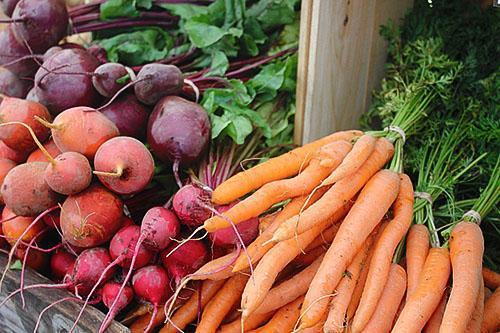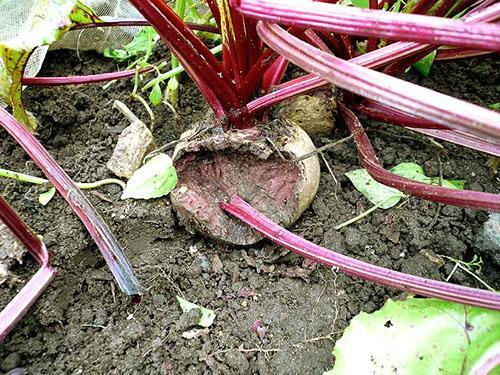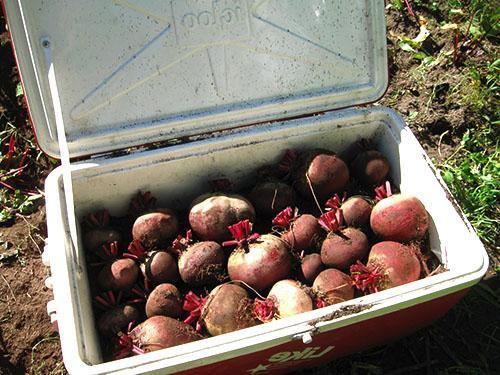How to store carrots and beets for the winter
 Root crops grown on household plots are traditionally used not only in summer, but are also laid for storage. This is facilitated by the unpretentiousness of crops and their productivity. The easiest way to save carrots and beets for the winter is to use heaps, cellars and cellars.
Root crops grown on household plots are traditionally used not only in summer, but are also laid for storage. This is facilitated by the unpretentiousness of crops and their productivity. The easiest way to save carrots and beets for the winter is to use heaps, cellars and cellars.
In conditions of low temperatures, root crops enter a period of rest, the growth of tops stops or slows down, there is no need to obtain moisture and nutrients.
But no matter how picky the culture was, during months of storage, beets and carrots inevitably lose moisture, they can be subject to rotting and infection with molds. And an increase in temperature at the storage site activates growth processes. In addition, not all root vegetables are stored equally well. Their ability to retain moisture and resist spoilage is influenced by both the timing of harvest and the original quality of the crop. How to store beets and carrots properly? What root crops will withstand a stay in a pile or basement for many months, and what to do with the rest of the crop?
When to harvest carrots and beets?

In rainy weather, when harvesting beets and carrots for winter is also not worth it, root crops accumulate moisture and are more prone to rot.
In the middle lane, carrots can be harvested from the second half of September to October, the main thing is that the harvest is harvested before the onset of stable frosts. Such a step, in comparison with early harvesting of root crops, will reduce shrinkage by 10–20% during the winter months.
The dates for harvesting beets, which rise above the soil level and are more exposed to frost, come a little earlier, when the tops turn yellow and dry massively. Usually this time falls on the first half of September, and there is no need to hesitate. After all, we must not forget about the activity of rodents, who do not shun root crops in rapidly emptying beds:
- When the time comes for harvesting, the roots are gently undermined, for which it is more convenient to use not a shovel, into a pitchfork.
- Then for the bundles of tops already manually carrot and the beets are removed from the soil.
- Leaving short, up to 2 cm long petioles, the greens are immediately removed.
- Root crops are allowed to dry, and after sorting they are sent for storage.
How to store beets and carrots properly?
 Beets are less demanding on storage conditions than carrots. Therefore, if there is ventilation in the basement or cellar, temperatures in the range of 2-6 ° C and humidity 85-95%, burgundy roots are perfectly stored along with potatoes in piles, boxes or containers:
Beets are less demanding on storage conditions than carrots. Therefore, if there is ventilation in the basement or cellar, temperatures in the range of 2-6 ° C and humidity 85-95%, burgundy roots are perfectly stored along with potatoes in piles, boxes or containers:
- However, beets, like carrots, can be stored for the winter in containers where vegetables are sprinkled with sand in layers. In order to avoid the development of pathogenic flora, up to 2% chalk or slaked lime is mixed into the sand.
- Home storage layers beets and carrots can be laid with thick paper or corrugated cardboard.
- Fresh sawdust, phytoncides and essential oils of which inhibit parasites and pathogens of putrefactive processes, resist well the drying of carrots and beets, as well as the reproduction of bacteria and fungi.
 Root crops pretreated with a mushy composition of clay mixed with water are well stored. After immersion in such a means, carrots and beets are removed, dried and stored in the basement, and thanks to the moisture-retaining clay layer, the crop is guaranteed to be protected from wilting and spoilage. How to store beets and carrots properly if you cannot use sand and clay? In refrigerated storage facilities, carrots and beets can also keep fresh in tight plastic bags with a capacity of 20 to 50 kg. Packages filled with vegetables are not tied, but placed vertically on the shelves.
Root crops pretreated with a mushy composition of clay mixed with water are well stored. After immersion in such a means, carrots and beets are removed, dried and stored in the basement, and thanks to the moisture-retaining clay layer, the crop is guaranteed to be protected from wilting and spoilage. How to store beets and carrots properly if you cannot use sand and clay? In refrigerated storage facilities, carrots and beets can also keep fresh in tight plastic bags with a capacity of 20 to 50 kg. Packages filled with vegetables are not tied, but placed vertically on the shelves.
As a result of the respiration of root crops inside the containers, high humidity and a concentration of 2-3% carbon dioxide are formed. Moreover, at temperatures close to zero and high humidity, there are no signs of rotting or the development of mold.
 It has been noticed that small and ugly root crops lose moisture by 10–20% more during storage than selected carrots and beets. But what if the perfect vegetables don't always grow in the beds? How to keep such carrots and beets for the winter? Throwing away the crop is not worth it, because even not the most beautiful and large specimens can be useful and get on the table in the form of homemade preparations. Beets and carrots can be frozen for the winter, and in several original ways. Root vegetables dry perfectly. These vegetables are salted, pickled and fermented, from sweet root vegetables delicious jam and jam, juices and candied fruits are obtained.
It has been noticed that small and ugly root crops lose moisture by 10–20% more during storage than selected carrots and beets. But what if the perfect vegetables don't always grow in the beds? How to keep such carrots and beets for the winter? Throwing away the crop is not worth it, because even not the most beautiful and large specimens can be useful and get on the table in the form of homemade preparations. Beets and carrots can be frozen for the winter, and in several original ways. Root vegetables dry perfectly. These vegetables are salted, pickled and fermented, from sweet root vegetables delicious jam and jam, juices and candied fruits are obtained.
Can beets and carrots be frozen for the winter?
Quick freezing of fresh carrots and beets allows you to preserve all the taste of these vegetables and their beneficial properties.
 In the simplest case, peeled and chopped root vegetables are dried on a paper towel, and then laid out in portions in bags, closed and sent to the freezer. Beets and carrots, frozen for the winter, can, if necessary, be added to any dishes during the heat treatment stage, be it soups, side dishes, gravies or roasts.
In the simplest case, peeled and chopped root vegetables are dried on a paper towel, and then laid out in portions in bags, closed and sent to the freezer. Beets and carrots, frozen for the winter, can, if necessary, be added to any dishes during the heat treatment stage, be it soups, side dishes, gravies or roasts.
 Since both beets and carrots require long boiling or stewing, the root vegetables are blanched for a few minutes before freezing and then poured over with cold water, which improves the taste and speeds up the cooking process.
Since both beets and carrots require long boiling or stewing, the root vegetables are blanched for a few minutes before freezing and then poured over with cold water, which improves the taste and speeds up the cooking process.
 If vegetables are chopped, then mashed carrots and beets can be frozen for the winter in portioned tins:
If vegetables are chopped, then mashed carrots and beets can be frozen for the winter in portioned tins:
- The resulting cubes are convenient to use
- They do not take up much space in the freezer.
- In this form, the beneficial properties of root crops are preserved until the next harvest.
 Similarly, for the winter, you can freeze beetroot and carrot juice, if desired, from which you can make a bright vitamin ice cream by adding yogurt, a little honey and orange juice.
Similarly, for the winter, you can freeze beetroot and carrot juice, if desired, from which you can make a bright vitamin ice cream by adding yogurt, a little honey and orange juice.
Storing beets and carrots in dried form
 An equally simple and affordable way to store beets and carrots is to dry root crops for the winter. Beforehand, vegetables are thoroughly washed, peeled and cut at the discretion of the hostess. The thinner the beet and carrot slices are, the less time it will take to remove moisture. You can dry root vegetables both in the oven and in a special dryer, the main thing is that the slices do not stick together and do not burn. Therefore, the raw materials are ted up from time to time and the temperature is monitored not to exceed 60–70 ° C.
An equally simple and affordable way to store beets and carrots is to dry root crops for the winter. Beforehand, vegetables are thoroughly washed, peeled and cut at the discretion of the hostess. The thinner the beet and carrot slices are, the less time it will take to remove moisture. You can dry root vegetables both in the oven and in a special dryer, the main thing is that the slices do not stick together and do not burn. Therefore, the raw materials are ted up from time to time and the temperature is monitored not to exceed 60–70 ° C.
Properly dried vegetables do not lose their original color and properties inherent in fresh crops.
 These carrots and beets can be added to your favorite soups, vegetable stews, and other dishes. Storing beets and carrots in this form does not require much space, and in a closed glass container the flakes remain unchanged throughout the year.
These carrots and beets can be added to your favorite soups, vegetable stews, and other dishes. Storing beets and carrots in this form does not require much space, and in a closed glass container the flakes remain unchanged throughout the year.
Salting and storage of beets and carrots
 For salting, it is best to take medium-sized root vegetables, which, after cleaning, are cut, blanched and laid out in clean jars, leaving some space at the neck. The containers are filled with boiling 2% brine, making sure that the liquid occupies all the cavities, and there are no air bubbles in the cans. Then the pickles are sterilized and covered with lids. It is better to store beets and carrots in this form in the cold, in a household refrigerator or basement.
For salting, it is best to take medium-sized root vegetables, which, after cleaning, are cut, blanched and laid out in clean jars, leaving some space at the neck. The containers are filled with boiling 2% brine, making sure that the liquid occupies all the cavities, and there are no air bubbles in the cans. Then the pickles are sterilized and covered with lids. It is better to store beets and carrots in this form in the cold, in a household refrigerator or basement.
Homemade carrots and beets for the winter
 Homemade preparations from beets, carrots and other vegetables in winter seriously replenish the menu and help to cope with the lack of vitamins in the diet. Many people know and love beetroot and carrot salads and snacks. Root vegetables go well with other garden crops, for example, cabbage and tomatoes, zucchini and eggplants, sweet pepper and spicy herbs.
Homemade preparations from beets, carrots and other vegetables in winter seriously replenish the menu and help to cope with the lack of vitamins in the diet. Many people know and love beetroot and carrot salads and snacks. Root vegetables go well with other garden crops, for example, cabbage and tomatoes, zucchini and eggplants, sweet pepper and spicy herbs.
Pickled beetroot and carrot cubes are a great help for making vinaigrette and other healthy snacks. Beets and carrots can be fermented, as of old, both together with white cabbage, and separately.
 Indispensable in winter is the bright pre-prepared dressing for borscht, where, in addition to carrots and beets, add onions, bell peppers and tomatoes, garlic, dill and parsley.
Indispensable in winter is the bright pre-prepared dressing for borscht, where, in addition to carrots and beets, add onions, bell peppers and tomatoes, garlic, dill and parsley.
- Peeled and chopped carrots and onions are fried.
- Next, beets are fried and stewed, at the half-cooked stage adding diced bell peppers and tomato.
- Combine vegetables, season with salt, vinegar, all the necessary spices and herbs.
- The dressing is laid out in jars, sterilized and closed.
Such summer preparation not only saves time, but also gives the borsch a truly summer taste and aroma. And the entire grown crop of root crops goes into business and benefits until the next garden season.